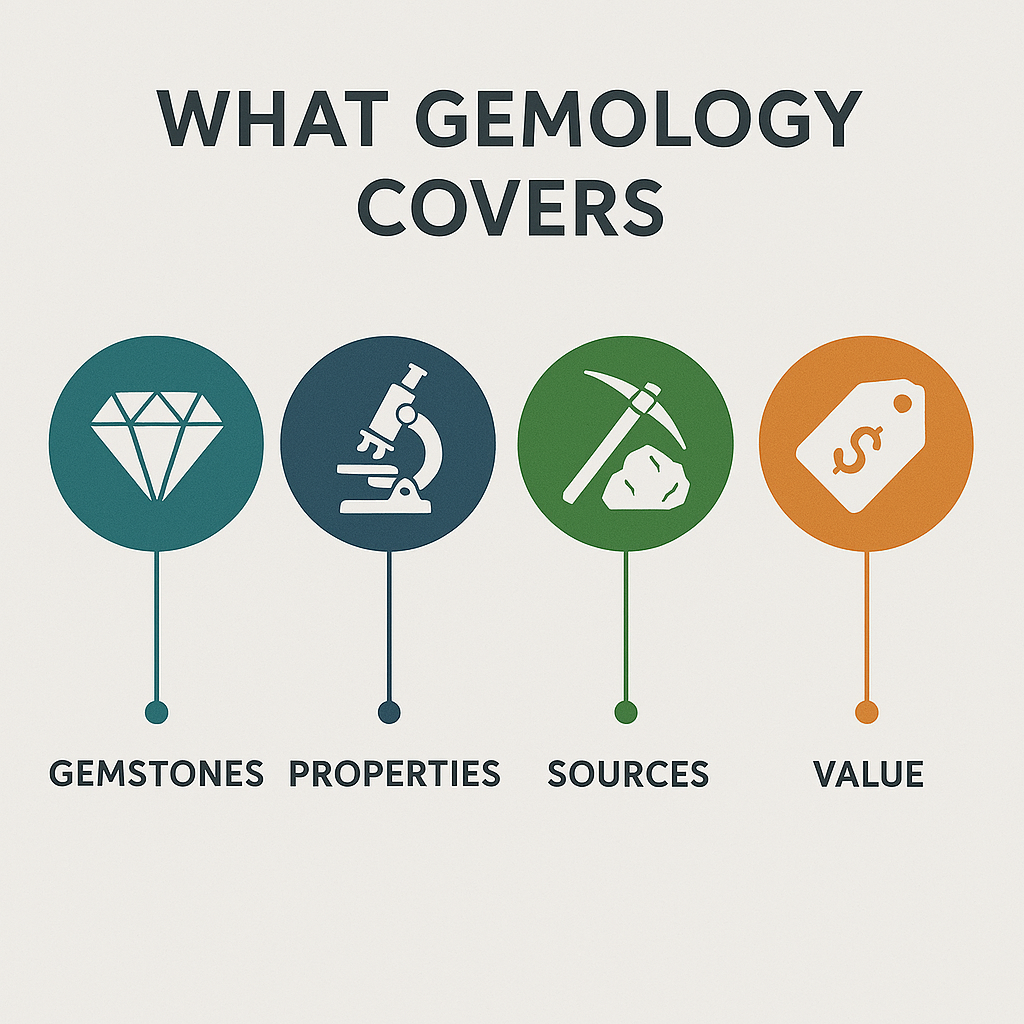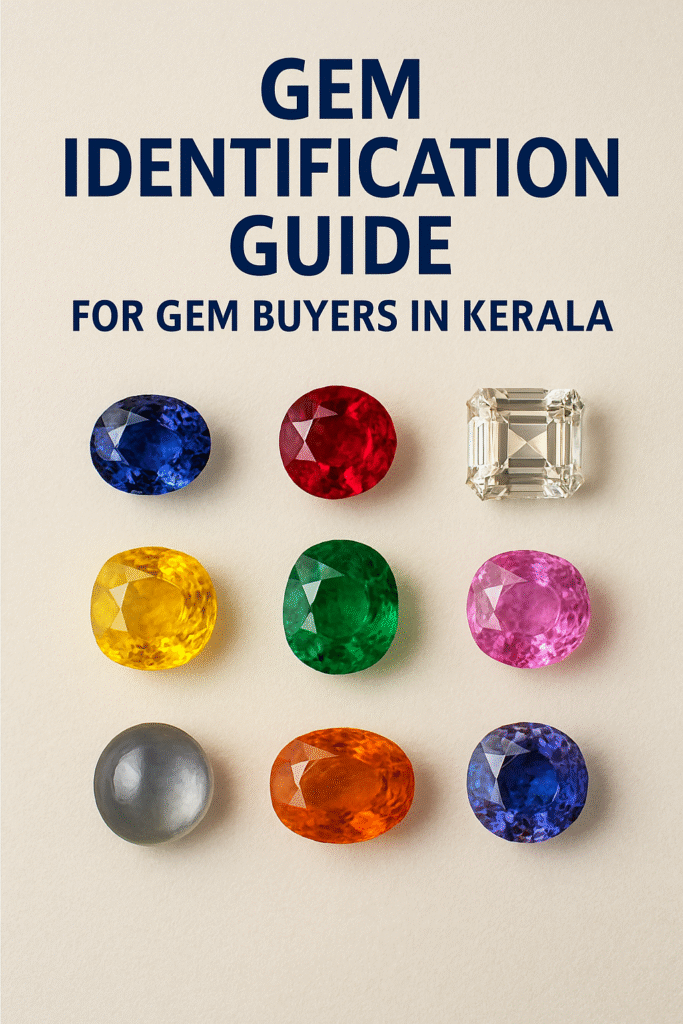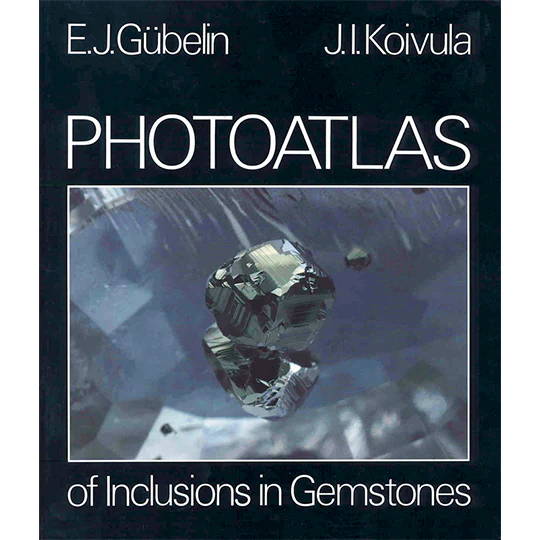Discover the hidden science, cultural wisdom, and timeless beauty of natural gemstones. With over four decades of expertise, I bring you stories that sparkle with insight and authenticity.

What Gemology Covers
Gemology is the science of gemstones and gem materials.
It focuses on how gems form, how they behave, and how you can identify them.
• Chemical and physical properties
Learn how gems react to heat, light, and pressure.
Understand why rubies and sapphires share the same mineral base.
• Optical characteristics
Study how gems bend light, show color, and sparkle.
Can you tell the difference between natural brilliance and artificial shine
• Synthetic and imitation gems
Discover how labs create synthetic diamonds and fake emeralds.
Know what tools help you spot the difference
• Cutting and polishing techniques
Explore how cutters shape rough stones into faceted gems.
Why does a poorly cut stone lose value?
• Gem identification tools
Use microscopes, refractometers, and spectroscopes.
Learn how each tool reveals clues about origin and authenticity.
• Grading and appraisal methods
Understand how experts assess clarity, color, cut, and carat weight.
Want to know what makes one sapphire worth more than another? Gemology helps you make informed choices when buying or selling gems. It gives you the skills to spot quality and avoid fraud. Are you ready to explore the science behind the sparkle?

The Gem Identification Process
Gem identification is a step-by-step process of elimination.
You start with an unknown stone.
Each test you perform removes some possibilities.
In the end, only one identity matches the stone.
That final match tells you its mineral group, species, and variety.
How to Approach Gem Identification
Work from the easiest observations to the more complex tests.
-
Begin with a visual check. Look at the color. Study the luster. Note any visible inclusions or surface features.
-
Move to intermediate tests
-
Check transparency and optical effect. Use a loupe or microscope for closer inspection.
-
-
Finish with advanced tests
-
Measure refractive index. Test specific gravity. Use spectroscopy for detailed analysis.
-
Why This Order Matters
Starting with simple observations saves time.
You avoid unnecessary testing on stones that can be identified quickly.
For example, a bright green stone with high luster and double refraction could be peridot.
You confirm by checking its refractive index and birefringence.
Ask yourself at each stage:
. What properties do I see?
. What stones match them?
. Which ones can I rule out?

The Gem Identification Process: A Step-by-Step Guide For Gem Buyers In Kerala
Gem identification is a logical process of elimination. You begin with an unknown stone. Each test rules out some possibilities. The final match reveals its mineral group, species, and variety.
Whether you are a gemologist, a jewellery buyer in Kochi, or a trader in Kerala’s gem or gold markets, the process remains the same.
Step 1: Start with Simple Observations
Begin with what you can see and feel.
-
Color – Is it bright, dull, or uneven?
-
Luster – Does it look glassy, silky, or metallic?
-
Transparency – Can you see through it fully, partly, or not at all?
-
Surface features – Inclusions, growth lines, or patterns unique to certain gems
Example: A bright green stone with oily luster could be peridot. But you confirm only after testing refractive index and birefringence.
Step 2: Move to Intermediate Tests
When visual checks are not enough, use tools.
-
Magnification – A loupe or microscope shows inclusions, fractures, and growth patterns
-
Optical effects – Check for pleochroism, chatoyancy (cat’s eye), or asterism (star effect)
-
Comparison – Match the stone against known samples for reference
Example: A ruby shows strong pleochroism under magnification. This property helps separate it from red spinel or garnet.
Step 3: Use Advanced Gemological Tests
Only after basic tests should you use specialized instruments.
-
Refractive Index (RI) – Measured with a refractometer; key to identifying most gems
-
Specific Gravity (SG) – Tells you the density, useful for separating look-alike stones
-
Spectroscope – Shows absorption patterns unique to gem types
-
Fluorescence – Helps confirm stones like ruby or diamond
Example: In Kerala, many buyers confuse red spinel for ruby. A quick RI test confirms the difference.
Why This Order Matters for Kerala’s Gem Trade
Buyers often rely only on color and appearance. That can be misleading. Traditional gems like emerald, ruby, sapphire, and coral are popular in Kerala jewellery markets. These stones often show distinct features visible even without advanced tools. Starting with simple checks saves time and avoids unnecessary lab costs. Ask yourself at every stage: What do I see? Which gems fit this property? Which ones can I rule out immediately?
Practical Tip for Kerala Buyers
Next time you are offered a gemstone in Thrissur or Kozhikode, don’t rely only on the seller’s word.
Even basic checks like luster, transparency, and magnification can protect you from costly mistakes.
Discover the definitive guide to gemstone inclusions with Gubelin & Koivula’s Photoatlas. Over 1400 photomicrographs help identify natural vs synthetic gems. Expert review inside.
The Essential Guide to Gemstone Inclusions
The Photoatlas of Inclusions in Gemstones Volume 1 stands as the gold standard for gemstone identification. This reference work changed how gemologists approach gem analysis.
Authors Eduard J. Gubelin and John I. Koivula created something special. They compiled microscopic evidence that helps you identify gems with confidence.
Why This Book Matters
You get access to over 1400 color photomicrographs. Each image shows specific inclusion patterns that reveal a gem’s identity.
The book covers gem materials discovered up to 1986. This timeline captures the foundation of modern gemology.
What Makes It Unique
Locality-Specific Features: The atlas shows you how gems from different locations display unique characteristics. You can trace a ruby’s origin by studying its inclusions. Natural vs Synthetic Identification: The photomicrographs reveal telltale signs that separate natural stones from lab-created gems. This knowledge protects you from costly mistakes. Microscopic Detail: Every image captures features invisible to the naked eye. You see the internal world that determines a gem’s value and authenticity.
Practical Applications
Do you work with gemstones professionally? This book becomes your diagnostic tool. Are you a collector? You learn to verify your specimens with scientific precision. The atlas helps you understand gem formation processes. You discover how inclusions tell the story of a stone’s creation.
Book Specifications
- Authors: Eduard J. Gubelin & John I. Koivula
- Edition: 4th Edition (2004)
- Pages: 532
- Format: Hardcover
- Images: Over 1400 color photomicrographs
Long-Term Value
This reference work maintains its relevance decades after publication. The fundamental principles of inclusion analysis remain unchanged.
The 4th edition includes updated research and improved image quality. You get the benefit of refined expertise.
Who Benefits Most
Gemologists rely on this atlas for daily identification work. Jewelry appraisers use it to authenticate valuable pieces. Students build their foundation with proven visual references. Collectors develop expertise in evaluating their specimens.
Investment Worth Making
Quality reference books hold their value over time. This atlas represents knowledge you can use throughout your career.
The comprehensive coverage eliminates the need for multiple specialized texts. You get complete inclusion documentation in one volume.
This comprehensive review covers the Photoatlas of Inclusions in Gemstones Volume 1 by Gubelin and Koivula. The post explains why this 532-page reference book with over 1400 photomicrographs remains essential for gem identification. Key benefits include distinguishing natural from synthetic gems, identifying locality-specific features, and understanding microscopic characteristics. The content targets gemologists, jewelry professionals, collectors, and students seeking authoritative guidance on gemstone inclusions and identification techniques.
Photoatlas of Inclusions in Gemstones Volume 2
Master gemstone inclusion identification with Volume 2 of Photoatlas of Inclusions in Gemstones. Features 2,200+ photomicrographs, diagnostic methods, and commercial gem analysis by Gubelin & Koivula. The second volume of Photoatlas of Inclusions in Gemstones transforms how you identify inclusions in precious stones. Authors Eduard J. Gubelin and John I. Koivula bring decades of expertise to this comprehensive resource.
What You Get in This 829-Page Reference
- Over 2,200 color photomicrographs showing gem characteristics discovered since 1986
- Step-by-step analytical methods for inclusion identification
- Detailed chapters on commercially important gemstones
- Diagnostic techniques that separate natural from synthetic stones
- Geological correlation data linking inclusions to origin
Key Features That Set This Volume Apart
Color and Shape Analysis: Learn how inclusion color reveals gem formation history. Discover why shape patterns indicate specific geological conditions. Commercial Gem Focus: Get targeted information on gems that matter most to your business. Find practical data for diamonds, rubies, sapphires, and emeralds. Post-1986 Discoveries: Access the latest findings in gemstone inclusion research. Stay current with modern identification techniques.
Who Benefits from This Reference
Gemologists seeking advanced identification skills will find practical applications on every page. Jewelry professionals need this data to authenticate high-value stones. Students studying gemology gain access to real-world examples and proven methods.
Diagnostic Methods You Can Apply Today
The book covers proven techniques for:
- Microscopic examination protocols
- Inclusion photography best practices
- Geographic origin determination
- Treatment detection methods
Why Inclusion Study Matters for Your Work
Natural inclusions tell stories about gem formation. They reveal where stones formed and under what conditions. Synthetic gems show different inclusion patterns. You can spot lab-created stones by studying these differences. Treatment evidence appears in specific inclusion types. Heat treatment and filling leave distinct signatures.
Technical Specifications
Format: Hardcover. Publication Year: 2005. Page Count: 829 pages. Image Count: 2,200+ color photomicrographs. Authors: Eduard J. Gubelin & John I. Koivula
Building Your Gemological Library
This volume complements Volume 1 by focusing on analytical methods rather than basic inclusion types. Together, both volumes provide complete coverage of inclusion identification techniques. The photomicrographs serve as visual references you can compare with your own findings.
Practical Applications in Daily Work
Use this book to:
- Verify gem authenticity during appraisals
- Determine geographic origin for provenance reports
- Detect treatments that affect gem value
- Document unusual inclusions in rare specimens
The clear organization lets you find specific information quickly during client consultations.
The Photoatlas of Inclusions in Gemstones Volume 2 serves as a comprehensive reference for gemstone inclusion identification and analysis. This 829-page hardcover, published in 2005 by renowned authors Eduard J. Gubelin and John I. Koivula, features over 2,200 color photomicrographs documenting gemstone characteristics discovered since 1986. The book focuses on analytical methods, diagnostic techniques, and commercially important gems, providing practical tools for gemologists, jewelry professionals, and students to authenticate stones, determine origin, and detect treatments through inclusion study.


